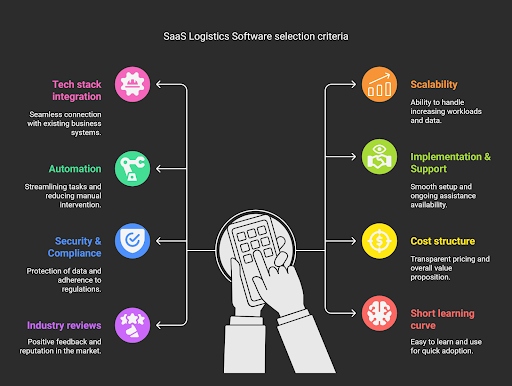- Logistics
SaaS Logistics Software: The Path to Scalable, Automated Operations
Table of Contents
- What Is SaaS Logistics Software?
- Why Logistics Is Moving Toward SaaS Models
- Essential Features of Modern SaaS Logistics Software
- Comparing SaaS Logistics Software vs. Traditional Logistics Systems
- Implementing SaaS Logistics Software: Strategic Considerations
- How FarEye Empowers Scalable, Automated Logistics with SaaS
- Future-Proofing Logistics Through SaaS-Enabled Operations
- Frequently Asked Questions

As a seasoned professional you’ve seen it all - an era where logistics scaling meant more servers and slower time-to-value to the pivot to fast and efficient SaaS logistics software. And now the next shift to AI-native platforms is more than just a technical change. It holds strategic importance and the early adopters are setting the pace.
According to a study by McKinsey, companies utilizing AI-driven supply chain solutions can reduce inventory levels by 15-30%, cut down costs by 5-10%, and improve service performance by 5-15%.
As agility becomes paramount in the industry, let’s explore how modern SaaS logistics software is set to change the game.
Must-Knows
- SaaS logistics software gives real-time visibility, cuts manual tasks, and improves delivery speed and accuracy.
- Logistics SaaS tools are faster to deploy and maintain than legacy systems, with more flexibility.
- Built-in AI helps optimize delivery routes, boost resource use, and improve on-time delivery rates.
What Is SaaS Logistics Software?
SaaS (Software as a Service) logistics software offers cloud-based tools that help companies manage inventory, transportation, and supply chain analytics. These platforms run on a web browser and automate manual tasks, process orders, and monitor live activity.
Unlike legacy systems, SaaS TMS deploys quickly, scales as per the business needs, and unifies all the logistics functions. Modern SaaS logistics software comes with AI-driven capabilities like predictive analytics, delay alerts, and dynamic route optimization. It also supports better visibility and decision-making while keeping the operating costs low.
Why Logistics Is Moving Toward SaaS Models
Logistics leaders are shifting to SaaS models to lower operating costs, reduce downtime, and scale quickly without IT overheads.
Here are the limitations of traditional on-premise systems and how SaaS improves speed, agility, and control:
Challenges and Limitations of Traditional On-Premise Systems
Slow Setup and Upgrade Cycles
On-premise logistics systems often take months to deploy. Hardware must be purchased, installed, configured, and tested, and updates usually need planned downtime and IT support. In fast-moving logistics environments, this delay leads to a slower speed to market, limited operational agility, and delays in ROI.
Rigid Infrastructure
Scaling with on-premise systems is a cost and resource-intensive process. Adding new carriers, warehouse locations, or service zones often requires manual configuration and custom development. That slows down growth and creates dependencies on IT. As market conditions shift, the company struggles to adapt quickly or affordably.
Security and Compliance Concerns
On-premise systems often fall behind on security updates and patching. This creates weak points that are harder to detect and easier to exploit. Also with frequent regulatory changes, keeping systems compliant requires time, expertise, and constant monitoring. Internal teams also carry the full responsibility for configuration and data protection. Mistakes can cost you breaches. As operations scale, these risks grow and so does the time your team spends managing them.
Heavy IT Overhead
Traditional logistics software often comes with high fixed overheads. IT teams must handle maintenance, system performance, and data security. As the business grows, these costs increase, even if the software doesn't improve delivery speed or efficiency. Over time, the rising overhead can outweigh the value the system provides.
How SaaS Delivers Operational Agility, Speed, and Cost Efficiency
SaaS logistics platforms are agile, flexible and cut costs through automation. Here's how they improve operations without adding complexity:
Faster Deployment with Fewer Delays
SaaS platforms don’t require hardware, local servers, or long setup cycles. Teams can roll out the software quickly using just a web browser. It reduces delays, avoids major IT involvement, and helps logistics teams start optimizing routes, tracking deliveries, and managing orders without waiting months for full system deployment.
Scalability
As logistics networks grow, managing more locations, orders, and partners without losing control becomes difficult. SaaS platforms help by centralizing operations, offering real-time visibility, and removing the need for local setup. For example, a leading pharmacy retailer in the Middle East used FarEye to expand from 30 stores to over 100 while keeping delivery operations controlled and predictable. The platform helped centralize delivery management and improve first-attempt delivery rates, even as order volumes increased.
Real-time Tracking and Faster Decisions
SaaS systems offer live dashboards and alerts for your team to know the whereabouts across your delivery network. If your team still relies on delayed reports or manual order status checks, it ends up with late reactions or service failures. However, if your team has real-time visibility across operations, it could mean quick decisions and better control over the situation.
Dynamic Routing Solutions
Fixed routes struggle with traffic, delays, and delivery variability. Indonesia’s largest grocer adopted FarEye’s auto-routing solution to manage a high-volume delivery network. They executed over 100,000 routes and saved 10,000 hours. With dynamic routing, the company achieved a 94% on-time delivery success rate.
Lower Infrastructure and Support Costs
SaaS doesn’t require local servers, manual upgrades, or a large IT footprint. The provider handles software updates, and costs are predictable through subscription pricing. That lets logistics teams focus on operations instead of system upkeep. And if you’re spending more time maintaining your system than improving delivery performance, that’s a cost you can’t afford to pay.
Essential Features of Modern SaaS Logistics Software
Modern SaaS logistics software offers real-time tracking, smart routing, inventory management, and seamless integrations.
Let’s explore these essential features in detail that will help you move goods faster, manage inventory better, and build stronger supply chains:
Comprehensive Visibility and Round-the-Clock Updates
If your team can’t see an order in motion, they won’t be able to manage it. SaaS logistics platforms offer live updates across hubs, carriers, and vehicles. When delays or disruptions happen, you can see them early and act before customers notice anything. It helps minimize SLA breaches and shortens issue resolution time. For teams managing hundreds or thousands of shipments a day, SaaS TMS is the ideal choice.
Smarter and Efficient Delivery Routing
Fuel is one of your highest variable costs. SaaS-based routing platforms pick the best and most efficient routes based on the live traffic, weather, and capacity. For example, if a roadblock appears, the platform reroutes drivers automatically to keep shipments moving. It improves on-time delivery rates and cuts average fuel consumption per delivery. For one midmarket courier, dynamic routing can cut rerouting costs by 22% in under six months.
Advanced Inventory Management
Running efficient warehouses takes more than just keeping shelves full. SaaS platforms track stock levels live, predict reordering needs, and alert teams before inventory issues arise. By automating these steps, you prevent stockouts and avoid tying up cash in slow-moving items. For fast-moving SKUs, that means better shelf accuracy and fewer last-minute procurement costs.
Order Management and Fulfillment Automation
Every manual handoff adds time and risk. You want orders to move smoothly from placement to delivery. SaaS platforms automate the entire order cycle like confirmation, picking shipping, and returns. When everyone across sales, operations, and logistics shares the same live information, orders move quicker and mistakes drop. It leads to improved first-attempt delivery rates, better customer service, and fewer return volumes.
Pay as you go licensing
Whether you are a startup or a business expanding operations, you’d any day prefer paying for what you use rather than a significant upfront capital investment. SaaS logistics software offers that flexibility and enables you to scale up or down without long-term commitments to rigid pricing structures.
Data-Driven Reporting and Predictive Analytics
You make better decisions when you have better information. SaaS logistics platforms collect real-time data from shipments, inventory, and carrier activity. Predictive tools spot trends such as increasing demand or slower delivery times before they become bigger problems. Staying ahead means fewer disruptions and smoother day-to-day operations.
Enterprise-Grade Security and Compliance
Protecting customer and business data isn’t optional. Strong SaaS logistics systems build security into every layer with encryption, access controls, and monitoring. Providers also meet tough international standards like ISO, GDPR, and SOC 2. You don’t need to spend time on manual audits or updates, the platform handles it.
Seamless Integration and Dynamic Scalability
Logistics operations rely on many different systems working together. SaaS platforms integrate easily with your ERP, CRM, WMS, and TMS software, keeping information flowing without manual re-entry. When your business grows, so does the system, without extra infrastructure costs or complicated IT projects.
Comparing SaaS Logistics Software vs. Traditional Logistics Systems
| Criteria | SaaS Logistics Software | Traditional On-Premise Systems |
| Technology Approach | SaaS platforms are technology-driven and cloud-based. | Traditional systems use conventional methods with limited technology support. |
| Deployment Time | Fast, usually completed in a few days. | Slow, often taking several months. |
| Maintenance | Managed entirely by the provider. | Requires in-house IT teams for support and updates. |
| Upgrades | Frequent upgrades with minimal downtime. | Manual upgrades that take time and can result in downtime |
| Customization | Highly customizable; you can select only the features you need. | Limited customization; upgrades take months to deliver. |
| Workflow Simplicity | Streamlined workflows reduce operational complexity. | Complex workflows often slow down operations. |
| Data Accessibility | Data is stored in the cloud and accessible anytime, anywhere. | Access to data is slower and less flexible. |
| Error Management | Automated processes lower the chances of human error. | Manual processes increase the risk of mistakes. |
| Data Security | High levels of encryption and compliance with standards (ISO, GDPR, SOC 2). | Lower security standards; manual management is needed for data protection. |
| Server Hardware Needs | No need for physical servers or local hardware. | Requires on-site servers that need frequent maintenance and upgrades. |
| Hosting | Hosted on cloud-based servers with automatic backups. | Relies on local hosting, increasing the risk of data loss without proper backup. |
| Integration | Easily integrates with ERP, CRM, WMS, and daily business apps. | Limited integration; manual workarounds often needed. |
| Scalability | Easily scales up or down without major system changes. | Scaling requires new hardware and long IT projects. |
| Resilience | Built-in disaster recovery, automatic backups, and cloud failover. | Vulnerable to local server failures; higher downtime risk. |
| Total Cost of Ownership | Lower and predictable subscription-based costs. | High costs for hardware, upgrades, IT maintenance, and scaling. |
Implementing SaaS Logistics Software: Strategic Considerations
To implement SaaS logistics software successfully, you need strong system connections and the right vendor. A wrong integration setup slows down processes, creates delays, and weakens visibility across teams. Just as important is vendor choice, a platform that can’t grow as your business scale can create cost surges in rework, downtime, and support.
Let's look at the key integrations and what to look for in a vendor to support long-term growth:

1. Evaluate integration with your tech stack
ERP Integration
Your SaaS platform should connect with your Enterprise Resource Planning system. This keeps orders, billing, and inventory in sync across teams. Without it, you may face duplicate entries, slow updates, or reporting gaps that impact decision-making.
CRM Integration
Customer service teams need visibility into delivery progress. Linking your logistics platform to your CRM helps them check order status in real-time. It means faster responses to customer questions and fewer internal handoffs.
WMS Integration
A good connection to your Warehouse Management System (WMS) helps your team pick, pack, and ship without delay. Inventory updates flow automatically between systems, so you don’t have to rely on batch updates or manual checks.
TMS Integration
Your Transportation Management System should feed directly into your logistics platform. That link helps automate routing, freight billing, and carrier selection. Without it, dispatchers often work in silos, which slows down deliveries and adds cost.
2. Evaluate vendor suitability
Scalability
Choose a vendor whose system scales with your business. Whether you’re adding drivers, launching in new markets, or partnering with more carriers, the platform should scale without rework or added infrastructure.
Automation
Look for automation across core tasks like order processing, dispatching, returns, and tracking. When these run in the background, your team can focus on improving service instead of repeating manual steps all day.
Implementation timelines and support
Pick a vendor that offers instant time-to-value and offers implementation partners. At the same time, ongoing maintenance and support are crucial. Ask how often they release updates and how fast they respond to issues.
Security and Compliance Standards
Strong SaaS vendors follow security protocols like ISO, GDPR, and SOC 2. It protects customer data, ensures legal compliance, and reduces the risk of breaches without adding work for your internal IT team.
Cost structure
There are tools that work on yearly subscription models, while others may work on per user model or even custom pricing. Create an ROI case for the options available and choose the one that aligns with your needs.
Other considerations
Look for customer reviews, case studies, user friendliness and a shorter learning curve. These small considerations have a huge impact. Take time to research and schedule demos to evaluate the key criteria.
How FarEye Empowers Scalable, Automated Logistics with SaaS
FarEye helps logistics teams grow without slowing down. The platform supports fast setup, smart routing, real-time tracking, and hands-off automation. For companies facing high delivery volumes and limited IT bandwidth, FarEye becomes a control tower for smarter operations.
Here’s how FarEye makes logistics simpler and more scalable backed by real results:
Rapid Onboarding and Enterprise-Grade Integration
As delivery networks expand, the time it takes to onboard new carriers can limit how quickly a business scales. FarEye helped Creoate, a UK-based B2B marketplace, reduce its carrier onboarding time by 90%. By integrating with their order and inventory systems, FarEye allowed the team to bring on partners faster while keeping operations aligned across platforms.
Dynamic Routing
Route planning affects both cost and service quality. A courier company in Greece relied on fixed routes and manual updates that led to inefficiencies in last-mile delivery. FarEye introduced dynamic routing based on real-time traffic and vehicle capacity. It improved their fleet utilization and kept deliveries on schedule without manual adjustments.
Predictive Visibility
When teams operate without real-time delivery data, they often react too late to avoid delays. That same Greek courier lacked early visibility into route issues and service disruptions. With FarEye’s predictive tracking and live alerts, the team began identifying problems earlier and managing them proactively. As a result, they improved delivery accuracy and cut operational costs by 50%.
Workflow Automation
Manual coordination slows operations as volume grows. FarEye reduces that burden by automating steps like dispatching, tracking, exception handling, and returns. It keeps daily execution consistent while freeing up time to focus on scaling service. Automation reduces the risk of error and supports a more predictable delivery cycle at higher volumes.
Let’s talk about how you can make your logistics more flexible, automated, and ready for growth. Connect with us to see what FarEye can do for your operations.
Future-Proofing Logistics Through SaaS-Enabled Operations
SaaS logistics platforms help businesses move faster, stay flexible, and scale without complexity. They reduce manual work, improve visibility, and make operations easier to manage. In today’s fast-changing market, this kind of agility is no longer optional.
Looking ahead, SaaS platforms will go a step further. With AI, they’ll predict delays, forecast demand, and help teams act before problems arise. The goal is to move from reacting to planning ahead.
Companies that invest early in predictive, AI-enabled logistics tools will have a clear edge. They’ll run leaner operations, serve customers better, and adapt faster to market shifts.
Choosing SaaS isn’t just a tech decision, it’s a way to future-proof your supply chain.
Frequently Asked Questions
How Can SaaS Logistics Software Future-Proof Supply Chain Operations?
SaaS logistics software improves visibility, automates tasks, and scales easily with business needs. It helps supply chains respond faster to change, making operations more resilient and future-ready.
Is SaaS Logistics Software Secure Enough for Large-Scale Enterprise Operations?
Yes, SaaS logistics platforms use encryption, role-based access, and follow standards like ISO and SOC 2. These systems are designed to meet enterprise-level data security and compliance requirements.
What Are the Typical Cost Advantages of Adopting SaaS Logistics Platforms Over On-Premise Systems?
SaaS platforms reduce costs by removing the need for hardware, in-house maintenance, and long setup times. Pricing is subscription-based, making it more predictable and scalable.
What Is a SaaS Transport Management System?
A SaaS transportation management system (TMS) is a cloud-based platform that helps businesses manage routing, carriers, shipments, and freight costs. It offers real-time visibility and automated planning.
How to Pick the Best Logistics Management Software for Your Organization?
Start by identifying your key logistics challenges and integration needs. Choose a platform that offers scalability, automation, real-time tracking, and strong support for your operational goals.

Komal Puri is a seasoned professional in the logistics and supply chain industry. As the AVP of Marketing and a subject matter expert at FarEye, she has been instrumental in shaping the industry narrative for the past decade. Her expertise and insights have earned her numerous awards and recognition. Komal’s writings reflect her deep understanding of the industry, offering valuable insights and thought leadership.
Let's Talk to Our Experts and Optimize Your Deliveries Today!
An expert from our team will reach out within 24 hours
Related resources


